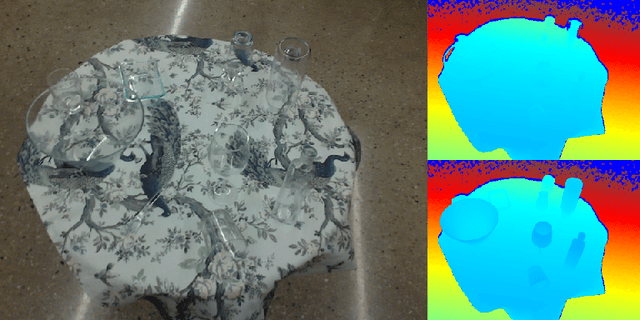Jiyue Zhu
Bunny-VisionPro: Real-Time Bimanual Dexterous Teleoperation for Imitation Learning
Jul 03, 2024Abstract:Teleoperation is a crucial tool for collecting human demonstrations, but controlling robots with bimanual dexterous hands remains a challenge. Existing teleoperation systems struggle to handle the complexity of coordinating two hands for intricate manipulations. We introduce Bunny-VisionPro, a real-time bimanual dexterous teleoperation system that leverages a VR headset. Unlike previous vision-based teleoperation systems, we design novel low-cost devices to provide haptic feedback to the operator, enhancing immersion. Our system prioritizes safety by incorporating collision and singularity avoidance while maintaining real-time performance through innovative designs. Bunny-VisionPro outperforms prior systems on a standard task suite, achieving higher success rates and reduced task completion times. Moreover, the high-quality teleoperation demonstrations improve downstream imitation learning performance, leading to better generalizability. Notably, Bunny-VisionPro enables imitation learning with challenging multi-stage, long-horizon dexterous manipulation tasks, which have rarely been addressed in previous work. Our system's ability to handle bimanual manipulations while prioritizing safety and real-time performance makes it a powerful tool for advancing dexterous manipulation and imitation learning.
TransNet: Transparent Object Manipulation Through Category-Level Pose Estimation
Jul 23, 2023



Abstract:Transparent objects present multiple distinct challenges to visual perception systems. First, their lack of distinguishing visual features makes transparent objects harder to detect and localize than opaque objects. Even humans find certain transparent surfaces with little specular reflection or refraction, like glass doors, difficult to perceive. A second challenge is that depth sensors typically used for opaque object perception cannot obtain accurate depth measurements on transparent surfaces due to their unique reflective properties. Stemming from these challenges, we observe that transparent object instances within the same category, such as cups, look more similar to each other than to ordinary opaque objects of that same category. Given this observation, the present paper explores the possibility of category-level transparent object pose estimation rather than instance-level pose estimation. We propose \textit{\textbf{TransNet}}, a two-stage pipeline that estimates category-level transparent object pose using localized depth completion and surface normal estimation. TransNet is evaluated in terms of pose estimation accuracy on a large-scale transparent object dataset and compared to a state-of-the-art category-level pose estimation approach. Results from this comparison demonstrate that TransNet achieves improved pose estimation accuracy on transparent objects. Moreover, we use TransNet to build an autonomous transparent object manipulation system for robotic pick-and-place and pouring tasks.
TransNet: Category-Level Transparent Object Pose Estimation
Aug 22, 2022



Abstract:Transparent objects present multiple distinct challenges to visual perception systems. First, their lack of distinguishing visual features makes transparent objects harder to detect and localize than opaque objects. Even humans find certain transparent surfaces with little specular reflection or refraction, e.g. glass doors, difficult to perceive. A second challenge is that common depth sensors typically used for opaque object perception cannot obtain accurate depth measurements on transparent objects due to their unique reflective properties. Stemming from these challenges, we observe that transparent object instances within the same category (e.g. cups) look more similar to each other than to ordinary opaque objects of that same category. Given this observation, the present paper sets out to explore the possibility of category-level transparent object pose estimation rather than instance-level pose estimation. We propose TransNet, a two-stage pipeline that learns to estimate category-level transparent object pose using localized depth completion and surface normal estimation. TransNet is evaluated in terms of pose estimation accuracy on a recent, large-scale transparent object dataset and compared to a state-of-the-art category-level pose estimation approach. Results from this comparison demonstrate that TransNet achieves improved pose estimation accuracy on transparent objects and key findings from the included ablation studies suggest future directions for performance improvements.
 Add to Chrome
Add to Chrome Add to Firefox
Add to Firefox Add to Edge
Add to Edge